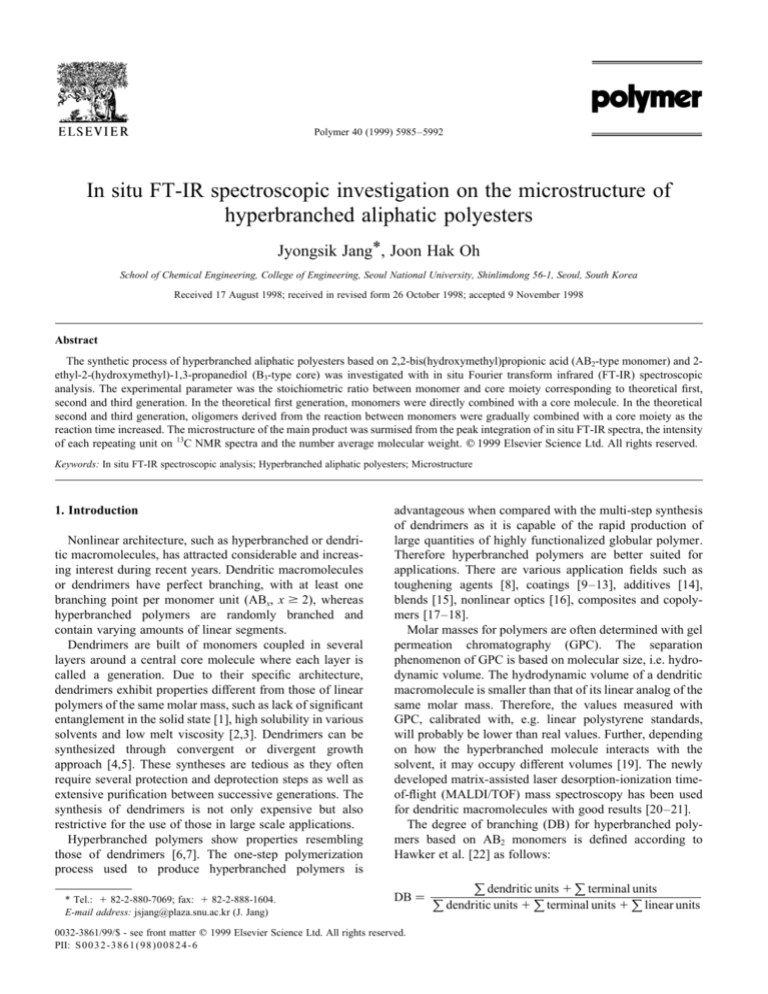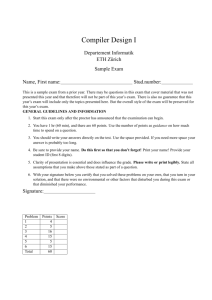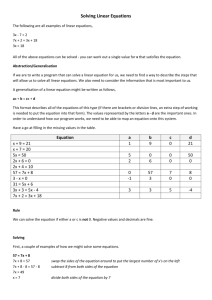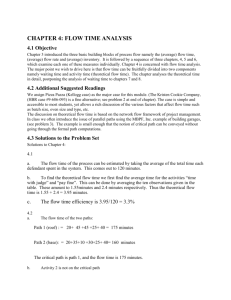
Polymer 40 (1999) 5985–5992
In situ FT-IR spectroscopic investigation on the microstructure of
hyperbranched aliphatic polyesters
Jyongsik Jang*, Joon Hak Oh
School of Chemical Engineering, College of Engineering, Seoul National University, Shinlimdong 56-1, Seoul, South Korea
Received 17 August 1998; received in revised form 26 October 1998; accepted 9 November 1998
Abstract
The synthetic process of hyperbranched aliphatic polyesters based on 2,2-bis(hydroxymethyl)propionic acid (AB2-type monomer) and 2ethyl-2-(hydroxymethyl)-1,3-propanediol (B3-type core) was investigated with in situ Fourier transform infrared (FT-IR) spectroscopic
analysis. The experimental parameter was the stoichiometric ratio between monomer and core moiety corresponding to theoretical first,
second and third generation. In the theoretical first generation, monomers were directly combined with a core molecule. In the theoretical
second and third generation, oligomers derived from the reaction between monomers were gradually combined with a core moiety as the
reaction time increased. The microstructure of the main product was surmised from the peak integration of in situ FT-IR spectra, the intensity
of each repeating unit on 13C NMR spectra and the number average molecular weight. q 1999 Elsevier Science Ltd. All rights reserved.
Keywords: In situ FT-IR spectroscopic analysis; Hyperbranched aliphatic polyesters; Microstructure
1. Introduction
Nonlinear architecture, such as hyperbranched or dendritic macromolecules, has attracted considerable and increasing interest during recent years. Dendritic macromolecules
or dendrimers have perfect branching, with at least one
branching point per monomer unit (ABx, x $ 2), whereas
hyperbranched polymers are randomly branched and
contain varying amounts of linear segments.
Dendrimers are built of monomers coupled in several
layers around a central core molecule where each layer is
called a generation. Due to their specific architecture,
dendrimers exhibit properties different from those of linear
polymers of the same molar mass, such as lack of significant
entanglement in the solid state [1], high solubility in various
solvents and low melt viscosity [2,3]. Dendrimers can be
synthesized through convergent or divergent growth
approach [4,5]. These syntheses are tedious as they often
require several protection and deprotection steps as well as
extensive purification between successive generations. The
synthesis of dendrimers is not only expensive but also
restrictive for the use of those in large scale applications.
Hyperbranched polymers show properties resembling
those of dendrimers [6,7]. The one-step polymerization
process used to produce hyperbranched polymers is
* Tel.: 1 82-2-880-7069; fax: 1 82-2-888-1604.
E-mail address: jsjang@plaza.snu.ac.kr (J. Jang)
advantageous when compared with the multi-step synthesis
of dendrimers as it is capable of the rapid production of
large quantities of highly functionalized globular polymer.
Therefore hyperbranched polymers are better suited for
applications. There are various application fields such as
toughening agents [8], coatings [9–13], additives [14],
blends [15], nonlinear optics [16], composites and copolymers [17–18].
Molar masses for polymers are often determined with gel
permeation chromatography (GPC). The separation
phenomenon of GPC is based on molecular size, i.e. hydrodynamic volume. The hydrodynamic volume of a dendritic
macromolecule is smaller than that of its linear analog of the
same molar mass. Therefore, the values measured with
GPC, calibrated with, e.g. linear polystyrene standards,
will probably be lower than real values. Further, depending
on how the hyperbranched molecule interacts with the
solvent, it may occupy different volumes [19]. The newly
developed matrix-assisted laser desorption-ionization timeof-flight (MALDI/TOF) mass spectroscopy has been used
for dendritic macromolecules with good results [20–21].
The degree of branching (DB) for hyperbranched polymers based on AB2 monomers is defined according to
Hawker et al. [22] as follows:
P
DB P
0032-3861/99/$ - see front matter q 1999 Elsevier Science Ltd. All rights reserved.
PII: S0032-386 1(98)00824-6
P
dendritic units 1 terminal units
P
P
dendritic units 1 terminal units 1 linear units
5986
J. Jang, J.H. Oh / Polymer 40 (1999) 5985–5992
spectroscopic experiment were prepared under following
directions.
Fig. 1. Chemical structures of monomer and core molecule: (a) bis-MPA;
(b) TMP.
For an ideal dendrimer, the DB is equal to unity. A hyperbranched polymer takes DB values between 0 and 1.
The synthesis of hyperbranched aliphatic polyesters,
based on 2,2-bis(hydroxymethyl)propionic acid (bis-MPA)
as an AB2 monomer and 2-ethyl-2-(hydroxymethyl)-1,3propanediol (TMP) as a core moiety, was described earlier
by Malmström et al. [23]. The DB for these hyperbranched polyesters was reported to be close to 80%, as
determined by 13C NMR in acetone-d6. However, since
the 13C NMR study was performed in acetone and small
residues of acid were present, most end-groups were transformed into acetonide endgroups. This made the calculation
of DB incorrect. When the DB was re-estimated from
dimethyl sulfoxide-d6, the right value was calculated to be
close to 0.5 [24].
Mansfield concluded that it was important to keep the
molecule as perfect as possible in low generations to
suppress polydispersity [25]. Therefore, the investigation
of microstructure of hyperbranched polymers corresponding
to low generations is of importance.
In this study we monitored the synthetic process of hyperbranched aliphatic polyesters, corresponding to theoretical
first, second and third generation, with in situ FT-IR spectroscopic analysis and investigated the microstructure of the
main product with the peak integration of in situ FT-IR
spectra, the intensity of each repeating unit on 13C NMR
spectra and the number average molecular weight.
2. Experimental
2.1. Materials
2,2-Bis(hydroxymethyl)propionic acid (bis-MPA) was
used as an AB2 type monomer and 2-ethyl-2-(hydroxymethyl)-1,3-propanediol (TMP) was used as a B3 type
core moiety. Fig. 1 shows their chemical structures. pToluenesulfonic acid (p-TSA) was used as an acid catalyst.
All chemicals were purchased from Aldrich and were used
as received.
2.2. Sample preparation
The samples for the measurement of the fraction of each
repeating unit and molecular weight were synthesized on the
direction described by Malmström et al. [23]. The synthesis
was not a pseudo-one-step reaction, but a one-pot
polymerization process. The samples for in situ FT-IR
2.2.1. Theoretical first generation
Bis-MPA (225 mg, 1.68 mmol), TMP (75 mg,
0.56 mmol) and p-TSA (1.1 mg, 0.5 wt% based on bisMPA) were dissolved in a beaker containing 20 ml of tetrahydrofuran (THF). The several drops of the solution was
coated on KBr pellet by spoid and the pellet was dried in
vacuum oven at 408C for 30 min. Then the pellet was
covered with another pure KBr pellet and was set up on in
situ FT-IR spectroscopic apparatus. The sample was
denoted as sample 1.
2.2.2. Theoretical second generation
Bis-MPA (278 mg, 2.07 mmol), TMP (31 mg,
0.23 mmol) and p-TSA (1.4 mg, 0.5 wt% based on bisMPA) were dissolved in a beaker containing 20 ml of
THF. The sample was prepared by the same method as
described in theoretical first generation and denoted as
sample 2.
2.2.3. Theoretical third generation
Bis-MPA (338 mg, 2.52 mmol), TMP (16 mg,
0.12 mmol) and p-TSA (1.7 mg, 0.5 wt% based on bisMPA) were dissolved in a beaker containing 20 ml of
THF. The sample was prepared by the same method as
described in theoretical first generation and denoted as
sample 3.
2.3. Instrumental analysis
Infrared spectra were recorded on a Bomem MB100
Fourier Transform Infrared (FT-IR) Spectrometer. Differential scanning calorimetry (DSC) analysis was performed on
a TA instrument using a heating/cooling rate of 108C/min.
The reaction temperature was determined as tip point of the
peak of melting in the curve. Relatively low esterification
temperatures were chosen to suppress unwanted side reactions such as etherification and trans-esterification. The
reaction temperatures for sample 1, 2 and 3 were 1428C,
1478C and 1538C. The reaction time was 2 h. Even though
it was shorter than real reactor scale, the conversion was
close to 100% because small amounts of reactants were used
on in situ FT-IR spectroscopic experiment.
Nuclear magnetic resonance (NMR) spectra were
recorded on a Lambda (JEOL) 300 MHz using dimethyl
sulfoxide-d6 (DMSO) as a solvent and using the solvent
signal as reference. The 13C NMR spectra were obtained
using the inverse gated decoupling mode (NNE: non NOE
experiment, T1 6 s, D1 50 s) where the NOE effect was
suppressed. The degree of branching was evaluated with the
method reported by Malmström et al. [23].
Matrix-assisted laser desorption-ionization time-of-flight
(MALDI/TOF) mass spectra were recorded on a HP G2025
J. Jang, J.H. Oh / Polymer 40 (1999) 5985–5992
5987
bending vibration of primary alcohol skeleton. The assignment of FT-IR bands is shown in Table 1.
3.1. Theoretical first generation (Sample 1)
Fig. 2. FT-IR spectra of monomer and core molecule: (a) bis-MPA; (b)
TMP.
LD/TOF. The matrix used for all samples was 2,5-dihydroxy-benzoic acid (DHB) and the solvent was THF.
3. Results and discussion
The FT-IR spectra of bis-MPA (monomer) and TMP
(core) are shown in Fig. 2. On the spectrum of bis-MPA,
the peak observed at 526 cm 21 is due to the bending vibration of primary alcohol C–C–O. The peak at 1456 cm 21 is
due to the CH3 asymmetric deformation vibration. On the
spectrum of TMP, the peak at 576 cm 21 is assigned to the
The change of in situ FT-IR spectra during synthesis of
sample 1 is shown in Fig. 3. The decrease of absorption
intensity of the peak at 526 21 cm 21 was mainly due to
the esterification between bis-MPAs because the reaction
was superior to the etherification between the primary alcohol of bis-MPA and the primary alcohol of TMP. The
absorption intensity of the peak at 576 cm 21 was decreased
as the esterification between bis-MPA and TMP proceeded.
The internal standard band, of which the intensity was not
affected even though the reaction proceeded, appeared at
1456 cm 21 due to CH3 asymmetric deformation vibration.
The peaks were separated by Lorentzian curve fitting
method. The absorption intensities of the peaks at 526 and
576 cm 21 were calibrated with that of the internal standard
band and plotted as a function of reaction time. The result is
shown in Fig. 4. The alcohol groups of TMP were more
reactive than those of bis-MPA even if the number of alcohol groups of bis-MPA (6) was more than that of TMP (3).
One of the reasons is melting point difference between bisMPA and TMP. The melting point of TMP (578C) is lower
than that of bis-MPA (181–1858C). The reaction temperature of sample 1 was 142. In the early stage of reaction,
primary alcohol groups of all TMPs were reactive, but
those of all bis-MPAs were not reactive. Bis-MPAs were
molten into TMP and the molten bis-MPAs were reacted
with TMP. Another reason is inductive effect. The carbonyl
group of bis-MPA is electron-withdrawing group. Therefore, the primary alcohol groups of bis-MPA are less
Table 1
Vibrational bands of bis-MPA and TMP and their assignments
Bis-MPA
n /cm 21
a
1687(vs)
1475(w)
1456(m)
1401(w)
1387(m)
1308(s)
1235(m)
1142(m 1 sh)
1046(vs)
1025(vs)
997(s)
869(m)
790(w)
636(m,b)
526(m)
a
TMP
Assignment
n /cm 21
Assignment
Carboxyl acid CyO str
CH2 scissors def
CH3 asym def
CH2 wag
CH3 sym def
Carboxyl acid C–O str
C–C–O asym str
In phase C–C–C str mixed
with in plane CH3 rock
1463(s)
1384(m)
1235(m)
1164(m 1 sh)
1058(s)
1035(s)
1012(s)
864(w)
CH3 asym def
CH3 sym def
C–C–O asym str
In phase C–C–C str mixed with in plane CH3 rock
Primary alcohol C–O str
Carboxyl acid OH def
(out of plane)
CH3 rock mixed with C–C str
CH2 rock
Primary alcohol C–OH def
(out of plane)
Primary alcohol C–C–O bend
Primary alcohol C–O str
CH3 rock mixed with C–C str
777(m)
642(m,b)
576(m)
CH2 rock
Primary alcohol C–OH def (out of plane)
Primary alcohol skeleton bend
537(w)
C–C in plane bend
Intensity: s, strong; m, medium; w, weak; v, very; sh, shoulder; b, broad.
5988
J. Jang, J.H. Oh / Polymer 40 (1999) 5985–5992
Fig. 5.
Fig. 3. In situ FT-IR spectral change during synthesis of sample 1: (a)
0 min; (b) 15 min; (c) 30 min.
reactive than those of TMP. The absorption intensity of the
peak at 576 cm 21 was decreased to a finite value (about
31%) within 30 min. Since one TMP molecule has three
primary alcohol groups, two primary alcohol groups in a
TMP molecule are believed to be combined with bis-MPAs.
The fraction of each repeating unit was obtained by
inverse gated decoupling 13C NMR technique where the
NOE effect was suppressed. Each repeating unit was
assigned on 13C NMR spectra with the same method as
described by Malmström et al. [23]. They assigned each
repeating unit using the chemical shift difference [terminal
unit (ppm): 50.65, linear unit (ppm): 48.85, dendritic unit
(ppm): 46.80] of the quaternary carbon in model compounds
and obtained the DB by integrating its intensity. The 13C
NMR spectrum of sample 1 is illustrated in Fig. 5. The
13
C NMR spectrum of sample 1.
integrated intensities of terminal, linear and dendritic unit
were 1.30, 1.00 and 0.00, respectively. The number average
molecular weight of sample 1 measured with MALDI-TOF
technique was 620 g/mol. The molecular weight of a TMP is
134 g/mol. The total weight of bis-MPAs coupled around a
TMP was approximately obtained by subtracting the molecular weight of a TMP from that of sample 1, i.e. 486 g/mol.
The molecular weights of terminal, linear and dendritic unit
are 117, 116 and 115 g/mol, respectively. Therefore, the
number of all repeating units coupled around a core moiety
was about 4. Consequently, the numbers of terminal, linear
and dendritic units were evaluated to be about 2, 2 and 0,
respectively. Table 2 shows the theoretical and experimentally measured values such as the number average molecular
weight, the DB, 13C NMR intensity and the number of each
repeating unit. Although the input molar ratio of monomer
and core was 3: 1, 4 monomers were coupled around a core
molecule. The result obtained from MALDI-TOF technique
showed the existence of molecules having high molar
masses (e.g. 968, 1084 g/mol). Therefore, it is believed
that small molecules could be combined with each other.
Judging from these results, it is possible to determine the
main structure of theoretical first generation. Fig. 6 shows
the main structure of sample 1. This correlates well to the
structure predicted by in situ FT-IR spectroscopic analysis.
3.2. Theoretical second generation (Sample 2)
Fig. 4. Peak integration of in situ FT-IR spectra of sample 1: (B) 526 cm 21;
(W) 576 cm 21.
Fig. 7 shows the change of absorption intensity of the
peaks at 526 and 576 cm 21 during the synthesis of theoretical second generation. The absorption intensity of the peak
at 576 cm 21 was decreased rapidly in the early stage of
synthesis and decreased slowly to a finite value (about
29%) in the later stage of synthesis. Therefore, two primary
alcohol groups in a TMP molecule are believed to be
combined with bis-MPAs. Unlike theoretical first generation, the absorption intensity of the peak at 526 cm 21 was
decreased rapidly within 25 min, afterwards remained
constant. That means the reaction between bis-MPAs
proceeded actively. This phenomenon can be explained as
follows. The elevation of reaction temperature (1478C)
enables more bis-MPAs to be molten actively. Since the
amount of bis-MPAs in the second generation was relatively
J. Jang, J.H. Oh / Polymer 40 (1999) 5985–5992
5989
Table 2
Theoretical and experimentally measured values for the hyperbranched aliphatic polyesters
Sample no.
Molar ratio (TMP:bis-MPA)
Theor. gen. a
Mn(g/mol)
DB b
13
T
1
2
3
1:3
1:9
1:21
1
2
3
620
1231
1688
0.57
0.45
0.44
C NMR intensity
c
1.30
4.59
2.80
No. of each unit
L
D
T
L
D
1.00
6.83
4.83
0.00
1.00
1.00
2
3
4
2
5
7
0
1
2
a
Theoretical generation.
The degree of branching.
c
T, terminal unit; L, linear unit; D, dendritic unit.
b
more than that in first generation, the molten bis-MPAs
could react easily on each other as well as on TMP.
Considering the above results, it is believed that in the
early stage of synthesis, oligomers such as dimers or trimers
were formed from bis-MPAs and these oligomers were
combined with core moiety as the reaction time increased.
There is another evidence that supports the supposition.
The wavenumber of the band due to CyO stretching of ester
groups shifted gradually from 1716 to 1722 cm 21 as the
reaction time increased (Fig. 8). The hydrogen bond is
most stable when elements are located to form sixmembered ring. In these oligomers and a TMP reacted
with bis-MPAs, the oxygen in CyO of ester group can
form the stable hydrogen bond with the hydrogen of primary
alcohol of bis-MPA. Then, the force constant of CyO bond
is weakened and the band appears at low wavenumber. The
hydrogen bond is broken as the oligomers are combined to
core moiety. Therefore the force constant of the CyO bond
augments and the band due to CyO stretching shifts to a
higher wavenumber.
The integrated intensities of repeating units on 13C NMR
spectra are listed in Table 2. The number average molecular
weight of sample 2 was 1231 g/mol. The total weight of all
repeating units coupled around a TMP was about 1097 g/
mol. Therefore, the number of all repeating units coupled
around a core moiety was about 9. From the number of all
repeating units and the fraction of each repeating unit, the
numbers of terminal, linear and dendritic units incorporated
Fig. 6. The microstructure of sample 1.
into a TMP were evaluated to be approximately 3, 5 and 1,
respectively.
Considering above results and steric hindrance, we can
conjecture the synthetic route and the plausible structure of
main product. The schematic diagram of synthetic process
of theoretical second generation is shown in Fig. 9. The
architecture can be changed as the different incorporation
of the repeating units occurs.
3.3. Theoretical third generation (Sample 3)
Fig. 10 shows the integration of the peaks at 526 and
576 cm 21 during the synthesis of theoretical third generation. The synthetic route of sample 3 followed the similar
way as that of theoretical second generation. The absorption
intensity of the peak at 526 cm 21 was decreased rapidly
between 20 and 60 minutes. This means the esterification
between bis-MPAs proceeded actively and oligomers such
as dimers or trimers were formed as the result. Like sample
2, the wavenumber of the band due to CyO stretching of
ester group shifted gradually from 1717 cm 21 to 1724 cm 21
as the reaction time elapsed. It means that oligomers were
Fig. 7. Peak integration of in situ FT-IR spectra of sample 2: (B) 526 cm 21;
(W) 576 cm 21.
5990
J. Jang, J.H. Oh / Polymer 40 (1999) 5985–5992
Fig. 8. Shift of the band due to carbonyl stretching during synthesis of
sample 2: (a) 10 min; (b) 20 min; (c) 30 min; (d) 60 min; (e) 90 min.
combined with core moiety in the later stage of synthesis.
Since the integrated intensity of the peak at 576 cm 21 was
decreased to about 32% similar to sample 1 and 2, two
primary alcohol groups in a TMP molecule are believed to
be reacted with bis-MPAs.
In the early stage of reaction, the absorption intensity of
the peak at 576 cm 21 was decreased faster than that of the
band at 526 cm 21. This phenomenon was opposite to that of
the synthesis of sample 2. This can be explained as follows.
For in situ experiment of sample 3, the esterification reaction between bis-MPAs proceeded for 1 h. Whereas, for the
in situ experiment of sample 2, the esterification reaction
between bis-MPAs proceeded for 40 min. The perfect melting of bis-MPAs in sample 3 took more time than that in
sample 2. The amount of bis-MPAs in sample 3, whose
Fig. 10. Peak integration of in situ FT-IR spectra of sample 3: (B)
526 cm 21; (W) 576 cm 21.
melting point (1818C–1858C) is higher than the reaction
temperature, was relatively more than that in sample 2.
The elevation of reaction temperature in theoretical third
generation was less effective than that in theoretical second
generation. Therefore, it is concluded that the reaction
temperature played a important role in the consumption
rate of functional groups of reactants and the synthetic
process.
Fig. 9. The schematic diagram of synthetic process of sample 2.
J. Jang, J.H. Oh / Polymer 40 (1999) 5985–5992
5991
Fig. 11. The schematic diagram of synthetic process of sample 3.
The integrated intensities of repeating units on 13C NMR
spectra are listed in Table 2. The number average molecular
weight of theoretical third generation was 1688 g/mol.
Except a core moiety, the total weight of all repeating
units was approximately 1554 g/mol. From the molar
mass and 13C NMR intensity of each repeating unit, the
numbers of terminal, linear and dendritic units incorporated
into a TMP were evaluated to be about 4, 7 and 2, respectively.
Considering these results and steric hindrance, the
synthetic route and the feasible structure of main product
are believed to be like Fig. 11. The architecture can be
changed as the different incorporation of the repeating
units occurs.
4. Conclusions
The synthetic process and microstructure of hyperbranched aliphatic polyesters was investigated by in situ
FT-IR spectroscopic analysis with the help of peak intensity
of 13C NMR and molecular weight. In theoretical first
generation, four bis-MPAs were mainly combined with a
TMP core molecule, even though the molar ratio of bisMPA and TMP was 3:1. The result obtained from the
MALDI-TOF technique showed the existence of molecules
having high molar masses, which meant the small molecules
could be combined with each other. The microstructure of
the main product had two terminal units and two linear
units. In theoretical second and third generation, oligomers
were formed through the esterification of bis-MPAs in the
early stage and combined with a core moiety in the later
stage. The main structure of theoretical second generation
had three terminal units, five linear units and one dendritic
unit. The main structure of theoretical third generation had
four terminal units, seven linear units and two dendritic
units. In the early stage, the reaction rate of TMPs of theoretical third generation was higher than that of theoretical
second generation. The reaction temperature played a
important role in the consumption rate of functional groups
of reactants and the synthetic process.
Acknowledgements
This work was supported by a grant no. KOSEF 97-0502-09-01-5 from the Korea Science and Engineering
Foundation.
References
[1] Fréchet JMJ. Science 1994;263:1710.
[2] Hawker CJ, Farrington PJ, Mckay ME, Wooley KL, Fréchet JMJ. J
Am Chem Soc 1995;117:4409.
[3] Mourey TH, Turner SR, Rubinstein M, Fréchet JMJ, Hawker CJ,
Wooley KL. Macromolecules 1992;25:2401.
[4] Fréchet JMJ, Hawker CJ, Wooley KL. JMS — Pure Appl Chem
1994;A31(11):1627.
[5] Denkewalter RG, Kolc J, Lukasavage WJ. US Patent 4 28 872, 1981.
[6] Wooley KL, Fréchet JMJ. Polymer 1994;35:4489.
[7] Fréchet JMJ. JMS — Pure Appl Chem 1996;A33(10):1399.
[8] Boogh L, Pettersson B, Japon S, Manson J-AE. Proc ICCM-10
1995;6:389.
[9] Hult A, Johansson M, Malmström E, Sorensen K, WO 93/17060,
1993.
[10] Johansson M, Hult A. J Coat Technol 1995;67:36.
[11] Hult A, Johansson M, Malmström E. Macromol Symp 1995;98:1159.
[12] Pettersson B, Sorensen K. In: Proceedings of the 21st Waterborne,
5992
[13]
[14]
[15]
[16]
[17]
[18]
J. Jang, J.H. Oh / Polymer 40 (1999) 5985–5992
Higher-solids and Powder Coatings Symposium, New Orleans (Los
Angeles, USA), 1994:753.
Johansson M, Malmström E, Hult A. J Polymer Sci Part A Polym
Chem 1993;31:619.
Kim YH, Webster OW. J Am Chem Soc 1990;112:4592.
Massa DJ, Shriner KA, Turner SR, Voit BI. Macromolecules 1995;
28:3214.
Zhang Y, Wang L, Wada T, Sasabe H. Macromol Chem Phys
1996;197:667.
The Polymer Society of Korea, Division of Polymer Synthesis, Seoul
(Korea), 1998.
Gitsov I, Wooley KL, Hawker CJ, Ivanova PT, Fréchet JMJ.
Macromolecules 1993;26:5621.
[19] Newkome GR, Young JK, Baker GR, Potter RL, Audoly L,
Cooper D, Weis CL, Morris K, Johnson CS. Macromolecules
1993;26:2394.
[20] Leon JW, Fréchet JMJ. Polym Bull 1995;35:449.
[21] Sahota HS, Lloyd PM, Yeates SG, Derrick PJ, Taylor PC, Haddleton
DM. J Chem Soc Chem Commun 1994:2445.
[22] Hawker CJ, Lee R, Fréchet JMJ. J Am Chem Soc
1995;113:4583.
[23] Malmström E, Johansson M, Hult A. Macromolecules
1995;28:1698.
[24] Malmström E, Trollsas M, Hawker CJ, Johansson M, Hult A. Polymer
Mater Sci Eng 1997;77:151.
[25] Mansfield ML. Macromolecules 1993;26:3811.








